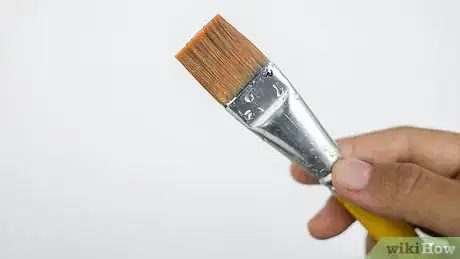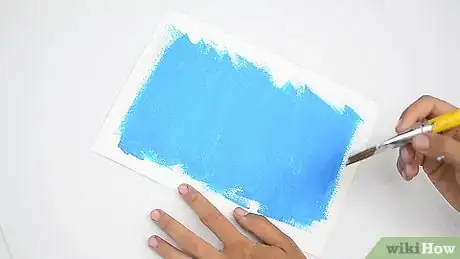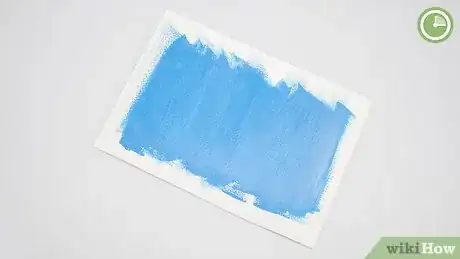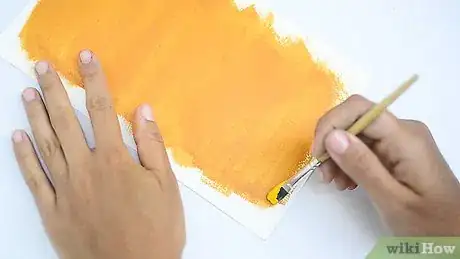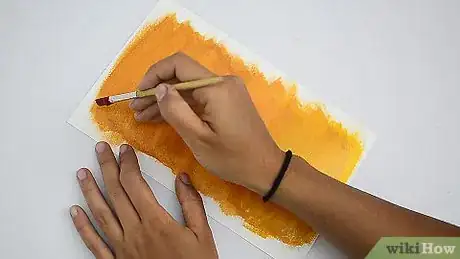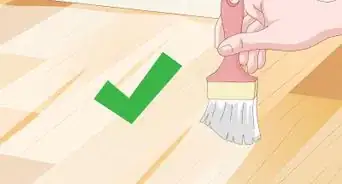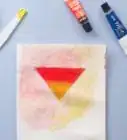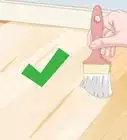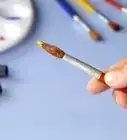This article was co-authored by Kelly Medford. Kelly Medford is an American painter based in Rome, Italy. She studied classical painting, drawing and printmaking both in the U.S. and in Italy. She works primarily en plein air on the streets of Rome, and also travels for private international collectors on commission. She founded Sketching Rome Tours in 2012 where she teaches sketchbook journaling to visitors of Rome. Kelly is a graduate of the Florence Academy of Art.
There are 16 references cited in this article, which can be found at the bottom of the page.
wikiHow marks an article as reader-approved once it receives enough positive feedback. This article received 12 testimonials and 100% of readers who voted found it helpful, earning it our reader-approved status.
This article has been viewed 276,792 times.
Blending acrylic paint is an effective way to seamlessly mix different colors together in a painting. The quickest way to blend is to use wet paint with wet paint, called "wet-on-wet," but you must also work quickly when doing it this way, as acrylic dries fast. Wet-on-dry paint is a little slower, but you have more time to blend. If you want to allow yourself even more time, try using an acrylic glaze to blend your paints.
Steps
Blending Wet Paint with Wet Paint
-
1Start with a damp brush. Soak your brush in water for a few minutes, then shake out the excess water. You don't want your brush to be dripping. You can brush it gently over a towel if you want.[1]
- Many brushes are good for blending, but you can try a flat, fan, round, or filbert brush to begin with.[2]
- If you're afraid of the paint drying out too quickly, you can paint your canvas with a bit of water, too. You do need to work quickly with this method, though.
-
2Paint one color in large strokes across the top of your canvas. Try to go back and forth across the whole canvas in a mostly straight line.[3] Cover at least 1 to 2 inches (2.5 to 5.1 cm) with the color.[4]
- For instance, you might start with dark blue on the top edge.
- You may want to cover more of the canvas, depending on how much of it you want to be just that color.
- You can also use this technique going in any direction across your canvas.
Advertisement -
3Brush a little bit of the second color across the canvas.[5] Without rinsing your brush, dip your brush into the color you're working towards. Paint along the bottom edge of the color on the canvas, moving back and forth as you go. Move down the canvas a little bit with the color, using broad strokes to blend it in with the color above. As you move back and forth, it should blend into the first color, lightening a bit as you move down.[6]
- For instance, if you're blending from dark blue to white, dip your brush into a little white.
-
4Use a bit more of the second color below the first color. Dab a bit more of the new color on your brush, and paint across the bottom edge of the current color. Move back and forth across the canvas in broad strokes, but move the strokes up and down to blend it into the previous color.[7]
- In the example, add a bit more white to your brush without washing it out.
- Keep going down the canvas, adding a bit more of the new paint each time. Use the same process across the whole canvas. Each time you add more of the new color, blend it in with broad strokes to the color above.[8]
- Remember to work quickly, as once the paint dries, you can't use the wet-on-wet method.
-
5Finish off at the bottom with just the new color. Rinse off your brush first, then dip it in the new color. Paint it across the bottom of the canvas, and then move up a little to blend it into the color above. Go back and forth across the canvas to fully blend it in.[9]
- So if you're blending to white, rinse all the blue out of your brush, then put just white on it to finish the bottom.
Trying the Wet-on-Dry Paint Method
-
1Paint a base coat in one of your main colors. Typically, you'll choose the darker of the two colors you're using. Paint broad strokes across the canvas, covering as much of it as you want with the color. Let the base coat dry completely.[10]
- For example, if you want to paint a blended sky, paint a solid medium blue background and let it dry completely.
- One nice thing about this method is you don't have to work as quickly.
-
2Wait for the base coat to dry. The base coat doesn't need to be completely dry before you continue, but it should be mostly dry. That way, you can easily add another color on top of the base coat.[11]
- If the base coat is thin enough, it should dry quickly, within 5-10 minutes.
-
3Begin painting one edge with your lighter color. Dip your paintbrush into the lighter color, and paint along one edge of the darker color. Create a solid line of color along that edge.[12]
- Start with quite a bit of paint on your brush.
-
4Move the color out towards the middle of the base coat. Without adding more paint to the brush, use broad strokes to expand the inner edge towards the middle of the dry paint. As you go, you'll have less and less paint on your brush, so it will get lighter.[13]
-
5Keep moving towards the other edge until you're happy. If your brush gets too dry, you can add a little water, which will help the paint go farther. Continue to use broad strokes along the edge, which will help make blending easier.[14]
Adding Acrylic Glazing
-
1Paint a solid background with your first color.[15] Start with your darker color, and paint as much of the canvas as you want to cover. Use broad strokes across the canvas to add the color.[16]
- You can also use this method without a base coat. Just use the glaze to blend the paint down to a more translucent color that just barely covers the canvas.[17]
-
2Mix your second color with a dollop of acrylic glazing medium. Acrylic glazing medium makes your paint a bit more transparent. Use your brush to pick up a large amount of the glazing and the paint color you want to blend.[18]
- Acrylic glazing medium comes in gloss, semi-gloss, and matte, so you can use whatever your preference is.
- You can work more slowly with this method. The glazing liquid does not dry as fast as the paint itself does, which gives you more time to perfect the blending.
-
3Paint the color and the glazing liquid on the canvas. Start on one edge of the base coat. Sweep your brush back and forth across the edge to apply the blending color and the glazing liquid together. Start moving towards the middle of the base coat.[19]
-
4Move towards the center, adding glaze as needed. As you get towards the center, you might want a bit more glaze to blend it in better with the base coat underneath. It will get slightly more transparent.[20]
- Use broad strokes to smooth it out.
-
5Add a darker color on the other edge if you'd like. If you decide the contrast isn't enough, mix glaze with a color that's darker then your base coat. Move towards the middle with it, using broad strokes back and forth to mix it in.[21]
- For instance, if you had a medium blue in the background, you might add a light blue on one edge and a dark blue on the other.
Expert Q&A
Did you know you can get expert answers for this article?
Unlock expert answers by supporting wikiHow
-
QuestionHow can I blend acrylic paint colors?
 Kelly MedfordKelly Medford is an American painter based in Rome, Italy. She studied classical painting, drawing and printmaking both in the U.S. and in Italy. She works primarily en plein air on the streets of Rome, and also travels for private international collectors on commission. She founded Sketching Rome Tours in 2012 where she teaches sketchbook journaling to visitors of Rome. Kelly is a graduate of the Florence Academy of Art.
Kelly MedfordKelly Medford is an American painter based in Rome, Italy. She studied classical painting, drawing and printmaking both in the U.S. and in Italy. She works primarily en plein air on the streets of Rome, and also travels for private international collectors on commission. She founded Sketching Rome Tours in 2012 where she teaches sketchbook journaling to visitors of Rome. Kelly is a graduate of the Florence Academy of Art.
Professional Artist
-
QuestionHow do I blend in paint colors?
 Community AnswerIn a new spot on your palette, mix a little bit of the darker color into the lighter color. gradually add a bit more of the darker color until you get the right shade.
Community AnswerIn a new spot on your palette, mix a little bit of the darker color into the lighter color. gradually add a bit more of the darker color until you get the right shade. -
QuestionHow do I thin out acrylic paints that are so thick they will not flow out of the bottle?
 Community AnswerJust open the bottle and add a little bit of water. Put the lid back on and shake it up really well.
Community AnswerJust open the bottle and add a little bit of water. Put the lid back on and shake it up really well.
Warnings
- Paint can stain clothes, so wear something you don't mind getting dirty.⧼thumbs_response⧽
Things You'll Need
- Canvas or illustration board
- Paintbrush
- A cup of water
- Acrylic paint, several colors
- Acrylic glazing liquid
References
- ↑ https://www.youtube.com/watch?v=C-Ft67tFCYg&feature=youtu.be&t=242
- ↑ https://www.creativebloq.com/illustration/how-choose-which-paint-brush-use-11618912
- ↑ Kelly Medford. Professional Artist. Expert Interview. 2 July 2019.
- ↑ https://www.youtube.com/watch?v=DwEgbzslecs&feature=youtu.be&t=26
- ↑ Kelly Medford. Professional Artist. Expert Interview. 2 July 2019.
- ↑ https://www.youtube.com/watch?v=DwEgbzslecs&feature=youtu.be&t=26
- ↑ https://www.youtube.com/watch?v=d0zuQuH-0F8&feature=youtu.be&t=52
- ↑ https://www.youtube.com/watch?v=DwEgbzslecs&feature=youtu.be&t=159
- ↑ https://www.explore-acrylic-painting.com/gradation.html
- ↑ https://www.youtube.com/watch?v=d0zuQuH-0F8&feature=youtu.be&t=134
- ↑ https://www.youtube.com/watch?v=d0zuQuH-0F8&feature=youtu.be&t=134
- ↑ https://www.youtube.com/watch?v=d0zuQuH-0F8&feature=youtu.be&t=134
- ↑ https://www.youtube.com/watch?v=_LRaGew8axw&feature=youtu.be&t=101
- ↑ https://www.youtube.com/watch?v=_LRaGew8axw&feature=youtu.be&t=101
- ↑ Kelly Medford. Professional Artist. Expert Interview. 2 July 2019.
- ↑ https://www.youtube.com/watch?v=d0zuQuH-0F8&feature=youtu.be&t=134
- ↑ https://www.youtube.com/watch?v=_LRaGew8axw&feature=youtu.be&t=151
- ↑ https://www.youtube.com/watch?v=d0zuQuH-0F8&feature=youtu.be&t=147
- ↑ https://www.youtube.com/watch?v=d0zuQuH-0F8&feature=youtu.be&t=172
- ↑ https://www.youtube.com/watch?v=d0zuQuH-0F8&feature=youtu.be&t=200
- ↑ https://www.youtube.com/watch?v=d0zuQuH-0F8&feature=youtu.be&t=214
About This Article
To blend acrylic paint, start by painting the first color in broad strokes across the top of the canvas. Next, dip your brush into the second color without rinsing it, then paint in long strokes along the edge of the first color so the colors blend. Try to use up-and-down strokes where the colors meet so the blending looks natural. Continue adding more of the second color as you move down the canvas a section at a time, blending it into the section above. Then, rinse your brush, paint the second color across the bottom, and blend it in! To learn how to blend acrylic paint using the wet-on-dry method, keep reading!
